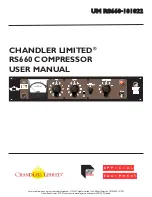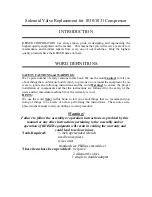
7
RS660-101022
Output Impedance
OUTPUT IMPEDANCE
is 600/200 ohms switchable. The 600
ohms setting may be more amenable to the modern studio
environment. The 200 ohms impedance setting was Abbey
Road Studios’ historic standard. Both settings offer tonal and
gain differences.
CONTROLS AND INSTRUMENTS
BAL.
The
BAL.
control set is a circuit re-balancing utility, and is lo-
cated at the far left of the front panel.
In any
push/pull
amplifier, one side pushes waveform, while
the other side pulls it in an equal fashion. Over time, the
push/pull balance may become irregular, and as a result, un-
wanted artifacts will occur in the audio. This is common to
most vacuum tube compressors, including the RS660.
When the push/pull circuit becomes unbalanced, it may
exhibit subtle rumbling or distortion and modulation of the
source signal; this is more noticeable at quiet sections of mu-
sic, and low frequencies.
If the RS660 is suspected of having become unbalanced, sim-
ply press inwards and hold the momentary “plunger” switch.
This action will induce a ticking sound heard in the monitors.
Use a small flathead screw driver and slowly adjust the trim
pot (located above the [BAL.] label) until the ticking sound
virtually disappears in the monitors. Once the ticking sound
is at its minimum audible level, rebalancing of the compres-
sion tube has been achieved; the ticking sound will never be
completely inaudible, only reduced.
®
dB
COMPRESSION
30
0
20
15 10 5
Historical note:
The RS660 BAL. feature is inherited from
the historic EMI / Abbey Road Studios RS124 Compressor.
Early versions of the RS124 did not have front panel BAL.
functionality. As a result, when the circuit became unbal-
anced, the compressor would have to be pulled during the
session and rebalanced by Abbey Road technical staff. This
scenario was cumbersome and the resultant session inter-
ruption was not ideal.
Abbey Road engineer Len Page had a proverbial ‘Light-Bulb’
moment when coming up with an ingenious modification.
When the momentary switch was engaged, a ticking sound
was sent to both amplifiers, with one being phase reversed. If
the circuit in a balanced state, the ticking would be canceled
out. Otherwise, the engineer would adjust the trim pot until
the audible ticking was virtually removed. This allowed for
convenient in-session rebalancing of the compressor by the
recording engineer in a matter of seconds.
INPUT
LINK
TIP- CV
SLEEVE- 0v
OUTPUT IMPEDANCE
200
600

































